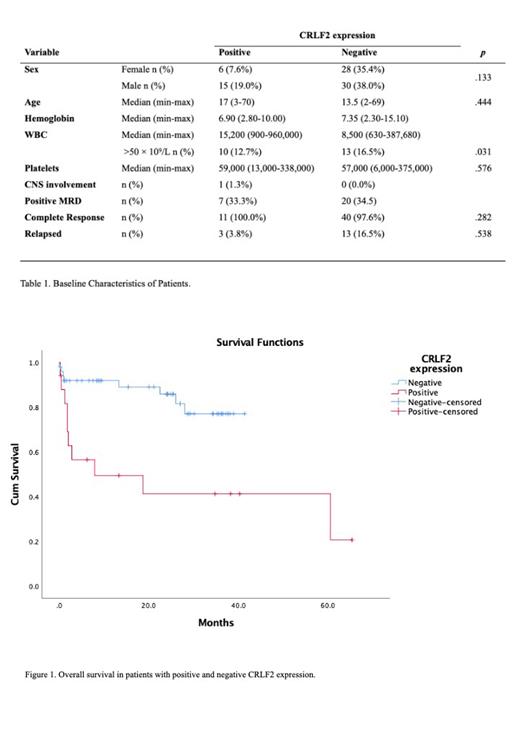Introduction
Acute lymphoblastic leukemia (ALL) is a hematological malignancy that primarily affects children also occurs in adults. Certain subtypes of ALL, such as Philadelphia chromosome-like ALL (Ph-like ALL), present unique challenges and are associated with poor outcomes. Alterations in the CRLF2 (Cytokine Receptor-like Factor 2) gene have emerged as critical contributors to the pathogenesis of Ph-like ALL. CRLF2 gene rearrangements result in the overexpression of CRLF2 protein, leading to dysregulated signaling pathways and enhanced leukemogenesis.
The prevalence and clinical implications of CRLF2 overexpression in Mexicans with ALL remain underexplored. Hence, this study aimed to investigate the prevalence of CRLF2 overexpression in Mexican patients with ALL across different age groups.
Patients and Methods:
We conducted a prospective study on a cohort of ALL patients from a single institution in Mexico that cares for patients across the age spectrum. Consecutive patients with a diagnosis of ALL were enrolled in the study and were assessed for CRLF2 overexpression using flow cytometry and fluorescent in situ hybridization (FISH). Patients were treated with a local BFM-based chemotherapy regimen according to age and risk stratification. In adolescents and young adults ≥16, a pediatric-inspired regimen was used and in patients with positive measurable residual disease (MRD) allogeneic hematopoietic cell transplantation was sought.
To determine the impact of CRLF2 overexpression on clinical characteristics and treatment response, we analyzed various parameters, including response rates, MRD, and survival. Statistical analyses were performed using SPSS 25, encompassing descriptive analysis, chi-squared tests, and survival analysis with the Kaplan-Meier method.
Results:
A total of 79 patients were enrolled with a median age of 17 years (2-70 years), 34 were female and 45 males with a median white blood cell count of 10.1x103/L (.63-649.57). Our findings revealed that 21 out of 79 patients (26.6%) exhibited CRLF2 overexpression. The proportion of CRLF positive ALL increased with age; it was 20.5% in patients aged 0-16 years, 34.6% in 17-39 and 40% in >60 years. There were no statistically significant differences observed in white blood cell counts, central nervous system involvement, response to treatment, or minimal residual disease levels in CRLF2 positive or negative patients (Table 1). In the Kaplan-Meier survival analysis, it was observed that positive CRLF2 expression was significantly associated with lower overall survival (OS) with a median of 24.9 months (0.2-65.4 months); with 85.8% OS at 2 years in CRLF2 negative vs 41.2% in CRLF2 positive patients (Figure 1). Event-free survival rate at 2 years was also lower with 70.8% vs 35.3% at 2 years in CLRF2 positive patients. Moreover, this association was found to be consistent across all age subgroups, including patients aged 0-16, 17-39, and over 40 years (P < 0.05).
Conclusion:
Our study highlights the significance of CRLF2 overexpression as a cost-effective biomarker indicative of an unfavorable prognosis in ALL across the age spectrum. Early detection of this alteration through flow cytometry plays a vital role in risk stratification and should prompt the implementation of tailored therapeutic interventions to improve clinical outcomes. Additionally, our study underscores the importance of conducting population-specific research to gain comprehensive insights into the genetic landscape and disease characteristics of ALL in different ethnic groups.
Disclosures
Gomez-Almaguer:Novartis: Honoraria; Janssen: Consultancy, Honoraria; AMGEN: Consultancy, Honoraria; AbbVie: Consultancy, Honoraria. Gomez-De Leon:AMGEN: Honoraria; Abbvie: Honoraria; Novartis: Honoraria; Astellas: Honoraria; Jnssen: Other: Advisory board; Sanofi: Honoraria.


This feature is available to Subscribers Only
Sign In or Create an Account Close Modal